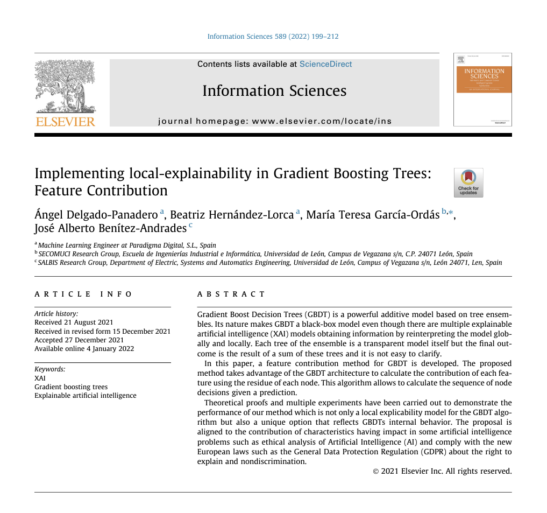Implementing local-explainability in Gradient Boosting Trees: Feature Contribution
- a Machine Learning Engineer at Paradigma Digital, S.L., Spain
- b SECOMUCI Research Group, Escuela de Ingenierías Industrial e Informática, Universidad de León, Campus de Vegazana s/n, C.P. 24071 León, Spain
- c SALBIS Research Group, Department of Electric, Systems and Automatics Engineering, Universidad de León, Campus of Vegazana s/n, León 24071, Len, Spain
Received 21 August 2021, Revised 15 December 2021, Accepted 27 December 2021, Available online 4 January 2022, Version of Record 7 January 2022.
Abstract
Gradient Boost Decision Trees (GBDT) is a powerful additive model based on tree ensembles. Its nature makes GBDT a black-box model even though there are multiple explainable artificial intelligence (XAI) models obtaining information by reinterpreting the model globally and locally. Each tree of the ensemble is a transparent model itself but the final outcome is the result of a sum of these trees and it is not easy to clarify.
In this paper, a feature contribution method for GBDT is developed. The proposed method takes advantage of the GBDT architecture to calculate the contribution of each feature using the residue of each node. This algorithm allows to calculate the sequence of node decisions given a prediction.
Theoretical proofs and multiple experiments have been carried out to demonstrate the performance of our method which is not only a local explicability model for the GBDT algorithm but also a unique option that reflects GBDTs internal behavior. The proposal is aligned to the contribution of characteristics having impact in some artificial intelligence problems such as ethical analysis of Artificial Intelligence (AI) and comply with the new European laws such as the General Data Protection Regulation (GDPR) about the right to explain and nondiscrimination.

